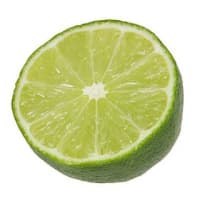Lime is a citrus fruit, which is typically round, green in color, 3–6 centimeters in diameter, and contains acidic juice vesicles.
The Persian lime (Citrus latifolia), which is a key lime and lemon hybrid, is the most widely produced lime globally.
The Key lime (Citrus aurantifolia = Citrus micrantha × Citrus medica) and the Kaffir lime (Citrus hystrix) are the other two most widely cultivated limes.
Limes readily hybridise therefore the majority of cultivated species in the world are actually hybrids, most likely produced from the citron fruit (Citrus medica), the mandarin orange (Citrus reticulata), the pomelo (Citrus maxima), and the micrantha (Citrus micrantha).
Healing Properties
Alkalizing
Antimicrobial
The concentration of phenolic content in the oils of the lime peel seem to be responsible for its antimicrobial effect. The higher the concentration, the greater the inhibition of bacterial or fungal growth.[1]
The essential oil of lime peels extracted by hydrodistllation contains antimicrobial compounds which can be used as preservatives in the food industries.[1:1]
Antibacterial
The essential oil of lime peels has very strong antibacterial activity on Bacillus subtilis DBDR 100, Clostridium botulinum ATCC 3584, Escherichia coli CCM 5172, Klebsiella pneumonia ATCC 12296 and Salmonella senftenbergy ATCC 8400.[1:2]
- Lime peel oil extracted by hydrodistillation (10µl) was more effective and completely inhibited the growth of A. niger and Penicillium sp compared with lemon peel oil.[1:3]
Antifungal
Lime oil has been shown to be more effective on fungal strains compared to lemon oil.[1:4]
Disease / Symptom Treatment
Study Type: In Vitro
Title: Antimicrobial Activity of some Egyptian Citrus Peels Extracts
Author(s): Ghada M. Kholaf; Emad G. Gomaa; and Hamid M. Ziena
Institution(s): Department of Food and Dairy Science & Technology, Faculty of Agriculture, Damanhour University, Damanhour, 22516, Egypt; Department of Food Sci. & Tech., Faculty of Agriculture,El- Shatby, Alexandria University, Alexandria, Egypt
Publication: Alexandria Science Exchange Journal
Date: October 2017
Abstract: Citrus juice production generates 15 million tons of wastes a year in the world, including peels, seeds and fruit pulps. This study aimed to evaluate the antimicrobial activity of extracted essential oils from six Egyptian citrus fruit peels. This antimicrobial activity was determined by paper disc diffusion method against six fungal strains and nine bacterial strains. Maximum inhibition zones were resulted against Penicillium sp and Aspergillus niger CAIM 147 with oils of lime and lemon peels which were extracted by hydrodistllation. In addition, the lime oil was more effective on fungal strains than lemon oil. The results showed also that oils of mandarin, sour orange and sweet orange peels extracted by the same method did not show any antifungal activity on the all tested fungi. While grapefruit peel extract has moderate effect on some fungal and bacterial growth. Also these essential oils of lime and lemon peels had very strong antibacterial activity on Bacillus subtilis DBDR 100, Clostridium botulinum ATCC 3584, Escherichia coli CCM 5172, Klebsiella pneumonia ATCC 12296 and Salmonella senftenbergy ATCC 8400. The essential oils extracted by organic solvents from all citrus fruit peels used in the present work were moderate weak activity against tested fungi and bacteria. The obtained results agreed with the phenolic contents in the essential oils extracted from citrus fruit peels and the results showed that increasing of phenolic content in these oils increased the diameter of inhibition zones of the all tested fungi and bacteria. The results showed that the lime peel oil extracted by hydrodistillation (10µl) was more effective and completely inhibited the growth of A. niger and Penicillium sp compared with lemon peel oil. Different concentrations of oil lime extracted by hydrodistllation were more effective against bacterial strains activities compared to lemon oil. B. subtilis was more sensitive at low concentration (10µL) of lime oil followed by K. pneumonia and S. senftenbergy at 30µL under the same conditions. And E. coli and Cl. botulinum were more resistant with lime oil until 50 and 40µL of lime oil, respectively. On the other hand, 20µL of lemon peel extracted by hydrodistillation completely inhibited the growth of B. subtilis, while the minimum inhibitory concentration (MIC) of oil lemon peel was 30µL for K. pneumonia and S. senftenbergy, 40µL for E. coli and 50µL for Cl. botulinum. Accordingly, the essential oils of lime and lemon peels extracted by hdrodistllation contained antimicrobial compounds which can be used as preservatives in the food industries.
Link: Source
Citations: ↩︎ ↩︎ ↩︎ ↩︎ ↩︎
